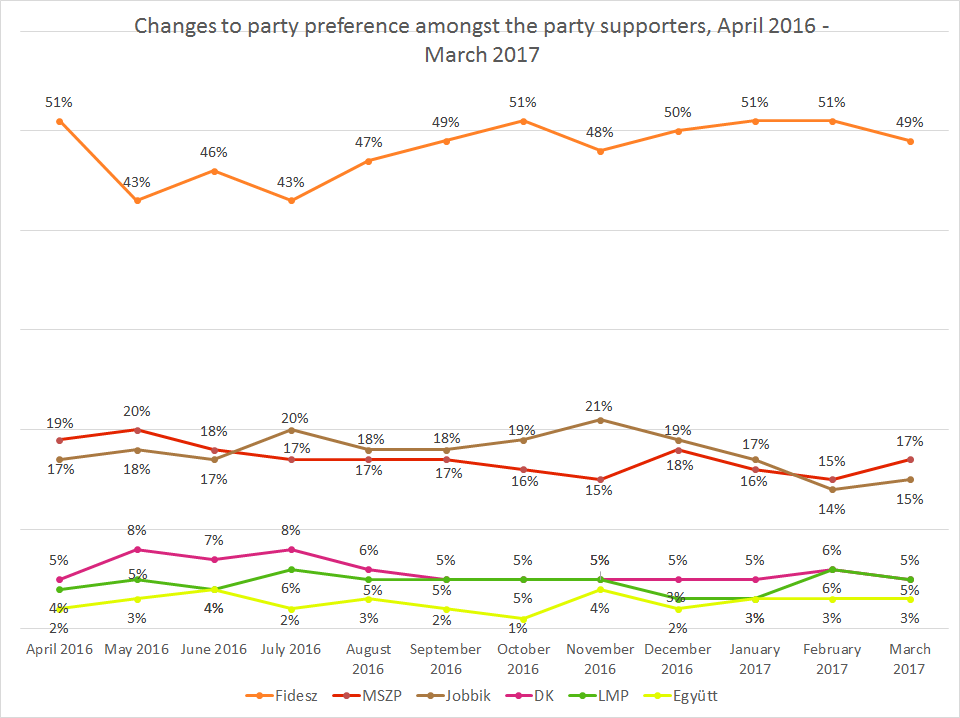

Socialists (MSZP) gain 2 percent in the new Republikon survey, while newly formed Momentum first enters our data with 2 percent. The gain of the Left can be attributed to the appearance of prime ministerial candidate László Botka. Fidesz still has a huge lead over all the other parties, while Jobbik is third after Fidesz and the Socialists. Ex-prime minister Ferenc Gyurcsány's party (DK) is at 6 percent while the green Politics Can Be Different (LMP) party is at 5 percent.
According to Republikon Institute’s mid-March findings MSZP has gained 1 percent amongst the whole population and 2 percent amongst party voters. This means that the effect of László Botka’s campaign remains limited but slight changes are noticeable.
The support of Fidesz remains stagnant at 30 percent, which is still a huge advantage to Jobbik’s 9 percent and to MSZP, now at 10 percent. Amongst smaller parties DK is at 4, LMP at 3, Együtt at 2, Magyar Liberális Párt (Liberals) at 1, and newly formed Momentum is also at 1 percent within the whole population, while Párbeszéd does not reach 1 percent. 2 percent would vote for parties not named in this survey and 38 percent said they were unsure or did not want to respond.
Amongst the party voters, the support of Fidesz decreased from 51 to 49 percent, while MSZP’s increased from 15 to 17 percent, this means MSZP is in the lead in the race against Jobbik, currently at 15 percent DK would reach the minimum figures to enter Parliament with its 6 percent and so would LMP with 5 percent. Együtt is at 3, while Momentum, measured by Republikon for the first time, is at 2 percent. Magyar Liberális Párt and Párbeszéd are both at 1 percent. Momentum has already reached similar support to the small left-wing liberal parties and stands as competitor for getting into Parliament. On the other hand, following the success of the signature collection against the Budapest Olympics, it is hardly a break-through that the newly formed party enjoys only double the support of Magyar Liberális Párt, the party of Gábor Fodor.
Momentum has already reached similar support to the small left-wing liberal parties and stands as competitor for getting into Parliament. On the other hand, following the success of the signature collection against the Budapest Olympics, it is hardly a break-through that the newly formed party enjoys only double the support of Magyar Liberális Párt, the party of Gábor Fodor.
Our research also measured preferences for the next government party- Fidesz, Jobbik or left-wing liberal- amongst different age groups. Through this, Republikon Institute aims to create an estimate for the elections.
Data shows that the government party is evenly supported by the different age groups. It is only amongst people aged 65 or older that the ratio of those wanting a continued Fidesz government remains below 50 percent.
The left-wing parties mainly enjoy popularity amongst pensioners. Only 15 percent of 18-24-year-olds and 35-44-year-olds favour a left-wing, liberal government for 2018 onwards and only one-fourth of those aged 45-64. Amongst those older than 64 every second person leans towards a left-wing cabinet.
In the case of Jobbik the figures are the opposite: while amongst the youth every fourth person would prefer a Jobbik- government, only 3 percent of people over the age 64 agree with this. Still, the popularist approach of Jobbik has visible effects: the radical party had been outstandingly popular amongst the youth before, but nowadays, the support for Jobbik is becoming evenly distributed from the ages 18 to 44.
